Understanding Aztec Religion
What the Aztecs Believed
The Aztec Empire existed in Central Mexico hundreds of years ago, from the 1300s to the 1500s. Their religion was a huge part of their daily lives. It influenced everything from farming to fighting.

One Force, Many Gods
The Aztecs had hundreds of gods, but they also believed in one main divine force. Priests thought all gods came from this single power. For everyone else, they worshipped individual gods that controlled different parts of the world.
This divine force was called teotl . It was not a person but a sacred energy that created and was part of everything. When the Aztecs conquered new people, they added the new gods to their own, seeing them as just another form of teotl .
The Aztecs did not have a specific name for their religion because it was part of everything they did. It was not separate from their government or daily work. It was simply the way they saw the world.
Core Beliefs and Cosmic Order
The Aztecs believed the universe had many layers. There were thirteen heavens above and nine underworlds below. They thought Earth was a flat disc in the middle of it all.
A key idea was duality, which means everything had an opposite that balanced it out. This included light and dark, hot and cold, and life and death. Their main creator god, Ometeotl, was both male and female.
The Aztecs believed they owed a debt to the gods. The gods sacrificed themselves to create the world and the sun. To repay this debt, humans had to make offerings, including human sacrifices.
Quick Facts About Aztec Beliefs
Aztec religion had over 200 gods, all seen as parts of a single energy called teotl . They believed the world had been created and destroyed four times, and they lived in the Fifth Sun. Human sacrifice was a way to repay the gods and keep the universe in balance.
They used two calendars to organize festivals and predictions. Your afterlife was not based on being good or bad, but on how you died.
The Aztec Gods and Goddesses
The Aztecs had many gods and goddesses, and each one was a form of the sacred force teotl . These gods were active in the world and could change their forms. They often merged with each other or appeared in different ways.
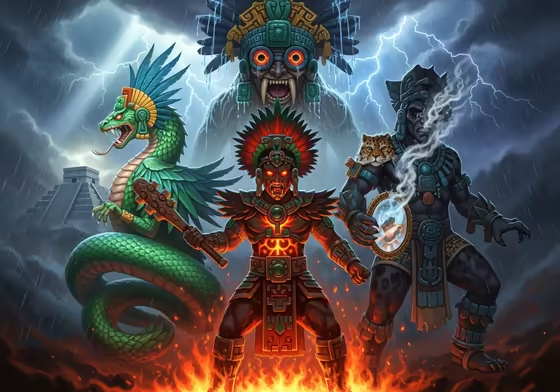
What Were the Gods Like?
There were over 200 gods, often grouped by themes like farming or war. But the gods were fluid, meaning they could blend together or have multiple forms. Sometimes a god had an animal counterpart called a nahual .
In important rituals, a person was chosen to be a deity impersonator, or ixiptla . They were dressed as a specific god and treated like one for a time. This showed the belief that gods could become physically present on Earth before the person was sacrificed.
The Most Important Gods
While there were many gods, a few were very important. For the Mexica people, who led the Aztec Empire, their main god was Huitzilopochtli. In the bigger creation story, four main gods created the world: Huitzilopochtli, Quetzalcoatl, Tezcatlipoca, and Xipe Totec.
Huitzilopochtli became important as the Aztec empire grew. At the Great Temple in their capital city, they built two shrines at the top. One was for Tlaloc, the ancient god of rain, and the other was for Huitzilopochtli, their god of war.
This showed respect for old traditions while highlighting their own power. It proved their military strength was just as important as farming.
- Huitzilopochtli ("Hummingbird of the South"): The most important god for the Mexica people, Huitzilopochtli was the god of war and the sun. Legend says he led them to the spot where they built their capital city. He needed the blood from sacrifices to stay strong and rise each day.
- Quetzalcoatl ("Feathered Serpent"): Quetzalcoatl was a god of wind, creation, and knowledge. He was a kind god who gave humans calendars and books. He is famous for traveling to the underworld to get the bones that created the people of the Fifth Sun.
- Tezcatlipoca ("Smoking Mirror"): Tezcatlipoca was a powerful and mysterious god of the night sky, destiny, and magic. He was the rival of Quetzalcoatl and could bring both good luck and disaster. His animal form was the jaguar.
- Tlaloc ("He Who Makes Things Sprout"): Tlaloc was the ancient god of rain, water, and farming. People loved him for bringing rain for their crops but also feared him for causing storms and floods. His rituals sometimes involved sacrificing children, as their tears were thought to bring rain.
- Mictlantecuhtli ("Lord of Mictlan"): As the god of death, Mictlantecuhtli ruled the underworld, called Mictlan. He was shown as a skeleton. He and his wife, Mictēcacihuātl ("Lady of the Dead"), watched over the souls of those who died of natural causes.
Death and the Afterlife
For the Aztecs, death was not the end but a part of a continuing cycle. They believed people had at least two souls. One soul stayed near the body, while the other began a journey to the afterlife.
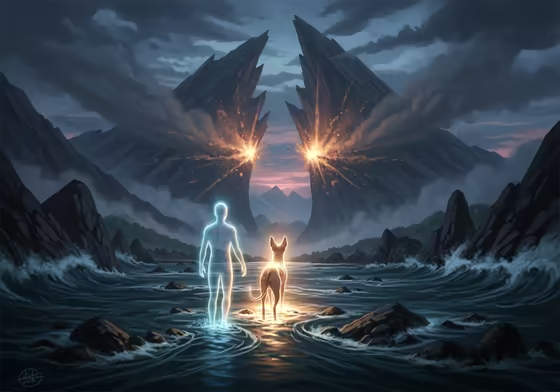
Where Souls Went After Death
Where a person's soul went did not depend on if they were good or bad. It was decided by how they died. There were three main destinations for souls.
- Ōmeyōcān (The House of the Sun): This was the best afterlife, a paradise for warriors killed in battle and women who died in childbirth. These souls would join the sun on its journey across the sky for four years. Afterward, they were reborn as hummingbirds and butterflies.
- Tlālōcān (The Place of Tlaloc): This was a beautiful place with endless spring and plenty of food. It was ruled by the rain god, Tlaloc. People who drowned or died from lightning strikes went to Tlālōcān.
- Mictlān (The Underworld): Most people who died from old age or sickness went to Mictlān, the underworld. It was not a place of punishment like hell. Instead, it was a dark and quiet place where souls went on a long journey.
| Destination | Ruling Deity | Criteria for Entry | Nature of Existence |
|---|---|---|---|
| Ōmeyōcān (House of the Sun) | Ōmeteōtl / Tonatiuh | Death in battle, sacrificial victim, death in childbirth. | Four years of glorious existence accompanying the sun, followed by reincarnation as a hummingbird or butterfly. |
| Tlālōcān (Place of Tlaloc) | Tlaloc | Death by drowning, lightning, or water-related diseases. | An eternal paradise of springtime, greenery, and abundant food. |
| Mictlān (The Underworld) | Mictlantecuhtli | Death from natural causes, old age, or general illness. | A four-year journey through nine perilous levels, culminating in total dissolution and eternal rest. |
The Journey Through the Underworld
The underworld, Mictlān, was ruled by the skeleton god Mictlantecuhtli and his wife. The journey through Mictlān was a four-year trip through nine dangerous levels. Families would bury their dead with tools and a dog to help guide the soul.
The nine levels of Mictlān presented a series of difficult challenges:
- Itzcuintlán/Apanoayan: The soul had to cross a deep river with the help of a spirit dog.
- Tepeme Monamictia: The soul passed between two mountains that crashed together.
- Iztepetl: The soul climbed a mountain made of sharp obsidian knives.
- Cehuecáyan: The soul faced freezing winds that cut like blades.
- Pancuecuetlacáyan: The soul crossed a desert where the winds tossed it around.
- Temiminalóyan: The soul was shot with arrows by invisible hands.
- Teyollocualóyan: Wild jaguars would eat the soul's heart.
- Apanohualóyan: The soul had to cross a lagoon of black water.
- Chiconahualóyan: At the final level, the soul was stripped of its identity and could finally rest in peace.
Sacred Symbols and Books
The Aztecs used a rich visual language to share their beliefs. They had many symbols and picture books. These were important for rituals and recording knowledge.
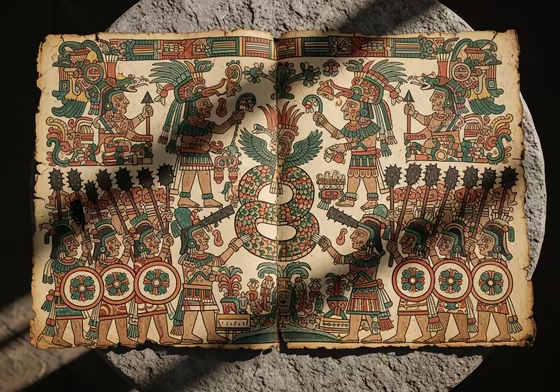
Important Aztec Symbols
The Aztecs did not have one main symbol for their religion. Instead, they used many images to represent their gods, nature, and ideas. These symbols were often woven together.
- The Eagle and the Serpent: The most famous Aztec symbol is an eagle on a cactus eating a snake. This image comes from the story of how they founded their capital city, Tenochtitlan. It represents the victory of the sun (the eagle) over the earth (the serpent) and is now on the flag of Mexico.
- The Feathered Serpent: This symbol is for the god Quetzalcoatl. It combines a snake (the earth) with bird feathers (the sky). It stood for the connection between the physical and spiritual worlds.
- The Jaguar: The jaguar was a symbol of the night, the underworld, and power. It was the animal form of the powerful god Tezcatlipoca.
- The Four Cardinal Directions: The Aztecs organized their universe around the four directions (north, south, east, and west). Each direction had its own color and god. This represented a balanced universe.
-
Other Key Symbols:
- Water ( Atl ) was a symbol of life and the god Tlaloc.
- Skulls, crossed bones, and flint knives were common symbols of death and sacrifice.
The Aztec Sacred Books
The Aztecs did not have one main holy book like the Bible. Instead, their myths, history, and religious knowledge were kept in picture books called codices.
These were not like modern books. They were made of long strips of animal hide or bark paper, folded like an accordion. They used pictures and symbols to record everything from family histories to religious ceremonies.
A priest would use a codex as a guide, not just reading it. The pictures helped them remember songs, stories, and the steps for rituals. This meant religion was something you did, not just something you read about.
Sadly, Spanish invaders destroyed most of these ancient books because they saw them as evil. Only a few survived. Many famous "Aztec" codices were actually made after the Spanish arrived, mixing native and European styles.
Aztec Religion and Its Neighbors
The Aztec religion did not appear out of nowhere. It grew from thousands of years of traditions in the region of Mesoamerica. It shared many core beliefs with other groups, like the Maya.
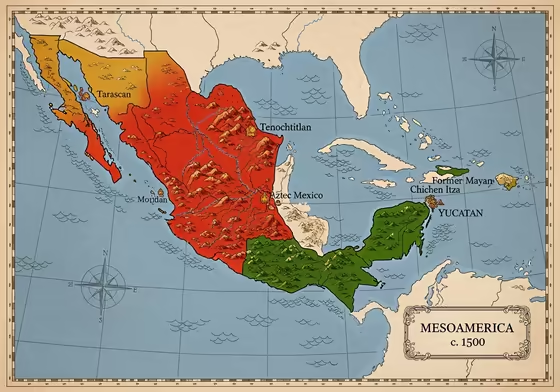
Aztecs vs. Mayans
Both the Aztecs and Mayans had many gods and believed the universe had multiple layers. They both used a 260-day and 365-day calendar. They also believed that sacrifice was needed to keep the gods happy and the universe in balance.
But the two cultures had different ways of showing their beliefs. These differences were shaped by their unique histories and values.
- Emphasis on Sacrifice: The Aztecs practiced large-scale human sacrifice as a core part of their religion and government. For the Maya, it was more common for kings and queens to offer their own blood in rituals. This was seen as a way to talk directly with the gods.
- Creation Mythology: The Aztecs believed the gods sacrificed themselves to create the current world. The Mayan creation story, from a book called the Popol Vuh , says the gods made humans from maize (corn) dough. This shows how important farming was to them.
- Deific Emphases: While they shared some gods, their main gods were different. The Aztecs' most important god was Huitzilopochtli, their god of war. The Mayans focused more on creator gods and farming gods.
| Domain | Aztec Deity | Mayan Deity | Key Differences in Iconography/Mythology |
|---|---|---|---|
| Feathered Serpent (Knowledge, Wind) | Quetzalcoatl | Kukulkán / Gucumatz | Quetzalcoatl's myth is strongly tied to the creation of humans from bones; Kukulkán is more central to Mayan state foundation myths (e.g., Chichen Itza). |
| Rain & Storms | Tlaloc | Chaac | Tlaloc is depicted with goggle-eyes and jaguar fangs. Chaac is often shown with a reptilian snout and wielding a lightning axe. |
| Sun & War | Huitzilopochtli (as Sun God) / Tonatiuh | Kinich Ahau | Huitzilopochtli is a uniquely Mexica patron god of war. Kinich Ahau is an alter ego of the Mayan creator god Itzanmá. |
| Earth Mother (Fertility) | Coatlicue | Ixchel | Coatlicue is a fearsome figure with a skirt of snakes, mother of Huitzilopochtli. Ixchel is a dualistic goddess of the moon, childbirth, and weaving. |
Geographic and Cultural Context
The Aztec religion grew in the heart of what is now Mexico. The empire's capital, the amazing city of Tenochtitlan, was built in 1325 on an island in a lake. Modern Mexico City now stands on this site.
From this central spot, the Aztec Empire grew to control a huge area. It stretched from the Pacific Ocean to the Gulf of Mexico.
Aztec Beliefs Today
The official Aztec religion ended when the Spanish conquered them in 1521. The Spanish tore down their temples and tried to force them to become Catholic. But many Aztec beliefs did not disappear, they just blended with the new religion.
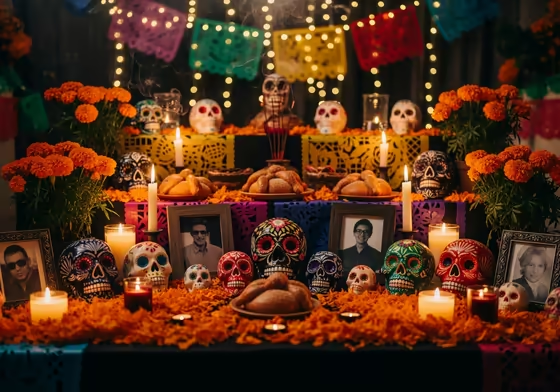
Mixing Old and New Beliefs
Today, the descendants of the Aztecs are the Nahua people. In their communities, ancient traditions are still alive and mixed with Catholicism. For example, Catholic saints are sometimes worshipped in ways that connect them to ancient Aztec gods.
A famous example is the Virgin of Guadalupe, the patron saint of Mexico. Her shrine is built on the same hill where the Aztecs once worshipped a mother goddess named Tonantzin. For many, the Virgin is just another form of this ancient goddess.
The Mexican holiday Día de los Muertos (Day of the Dead) also has deep Aztec roots. The tradition of making altars and offering food to ancestors comes from Aztec beliefs about honoring the dead. It celebrates death as a natural part of life.
Bringing Back Ancient Traditions
Some people are trying to bring back the original Aztec religion. A movement called Mexicayotl started in the 1950s to reclaim ancient traditions and beliefs. This movement has grown over the years, with groups in Mexico and the United States.
The survival of Aztec beliefs shows how resilient a culture can be. Even though the Spanish tried to erase their religion, the core ideas lived on. They adapted and are now being actively revived, proving that a worldview can outlast empires.